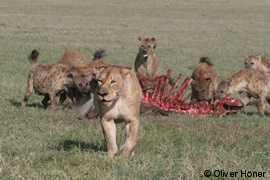Our Discoveries
The spotted hyenas in the Ngorongoro Crater have become one of the world’s best-studied populations of free-ranging mammals. Outstanding are the detailed genetic pedigree that includes virtually all Crater hyenas and the long-term life history data from several thousand individuals. With these unique data we assess the role of spotted hyenas in savannah ecosystems and study key questions in evolutionary biology and ecology.
Social behaviour and life in groups
Spotted hyenas live in large groups characterised by a strict linear dominance hierarchy. They express highly complex social behaviours to interact with each other, build coalitions, and persuade members of the other sex to mate with them. We study which factors lead to social dominance, how social status influences behaviour and survival of offspring, and which advantages and disadvantages life in groups provides.
Mate choice and sexual conflicts
Due to the special anatomy of their outer sexual organs, particularly the ‘pseudopenis’, female spotted hyenas have complete control over mating. This makes hyenas a perfect model species to study mate choice, its impact on female and male reproductive tactics, and conflicts between the sexes.
Competitors and pathogens: Evolutionary driving forces or threats?
Food competitors, predators and pathogens drive adaptations of free-ranging animals. In healthy ecosystems, competitors and pathogens rarely force populations of carnivores out of balance. But when does it happen? How much competition can hyenas and other carnivores tolerate? And what happens when novel pathogens are transferred from livestock to wild animals?










